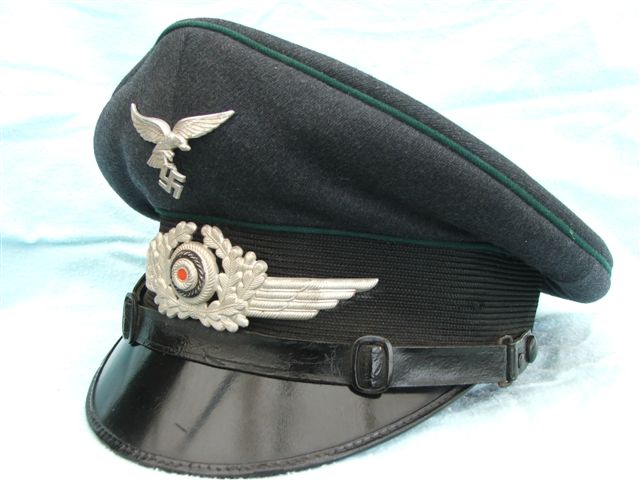
Bayern
-
Posts
2,103 -
Joined
-
Last visited
-
Days Won
6
Content Type
Profiles
Forums
Blogs
Gallery
Events
Store
Posts posted by Bayern
-
-
-
Hello, Appears to be an French Army Staff officer armband .the three colours denotes an Army Corps staff . the baided O and R indicates more precisely the status of the wearer but iam not able to said what means. a similar armband with the letters A and L braided implied that the wearer was attached to the Heavy Artillery of the Corps . Artillerie Lourde in French .
0 -
Hello Grey C . I like , to sell a certain image is not uncommon among famous architects , Albert Speer by case do more or less the same thing . In the other extreme Frank Loyd Wright or today Cesar Pelli , cultivated this way .
0 -
On 10/05/2007 at 05:53, Bob Lyons said:
As promised Paul, photos of my Admin NCO's cap....


Fine quality cap .
0 -
Hello , If he said that ...
0 -
Hello Trooper, Certainly i enjoyed it thanks again
0 -
Hello, Probably the changes in the uniform included the replacement of the Serbian cap by a peaked cap of the type used by Police officers , but in olive khaki or grey green . Milenko Brakovic was a member of the Serbian Gendarmerie mantained by the German occupants .He and other gendarm were the first deads of the Partisan Uprising in occupied Yugoslavia. In Bela Cerkva . if you enter his name and Bela Crkva to search . it will appear a photo of Brakovic wearing the 1941 uniform
0 -
Hello , The eagle with the spqr its probably Italian but not of the Police of the Publicca Sicurezza until 1946 .the PS badge have a Royal Crown , and the coat of arms of the House of Savoy on the breast of the eagle .After 1943 Mussolini created The Republic of Salo the Police was renamed Corpo di polizia Republicano but the badge is not that of the photo. After 1946 the PS was renamed Polizia de Stato and the badge changed ,the Royal crown on the head of the eagle was replaced by a mural crown and the coat of arms of the Savoys by a red shiel with the letters R I
0 -
Hello Trooper D ,Thanks for the link ,Is possible to read free the article with only registration
0 -
-
-
Thanks for share !
0 -
Peter, not all the Werndl bayonets were with wood grips but also is true that at least those of the Imperial Army have the characteristic hook in the lower guard but Werndl rifles were used also here in Argentina ,in Montenegro and Persia .
0 -
Hello, After the disintegration of the Austro Hungarian Empire the city of Kassa until these time part of Hungary went to the new State of Czechoslovakia and was renamed Kosice . it was in the Slovakian portion of the new nation . The Army of Czechoslovakia received many ex Imperial officers and specially in the Slovakian portion many traditions of the Imperial Army were retained including the cavalry school and equestrian skills
0 -
Very Interesting !
0 -
-
Hello ,The antique helm is the trademark of Weyersberg Kirschbaum & co of Solingen a well known German manufacturer of swords ,bajonets, sabres etc who sell his products not only in Germany . but abroad . your sword bajonet is curious due to the ebonite or hardened rubber grips. this points to a Austro Hungarian Werndl mod 1867 rifle.
0 -
Hello, Not Royal crown either Dutch or Belgian . as Graham said is a Eastern Crown ,the most antique type of crown .
0 -
Hello . Perhaps Oberleutnant zur see Delius was not the recipient of the Trophy but the donator.
0 -
Hello, expecting the pics
0 -
On 23/05/2010 at 08:55, Freiwillige said:
Fragment with a Bavarian king (?)
He is wearing a Hungarian Colonel Rock.

King Ludwig III of Bavaria was Colonel In Chief of the Imperial and Royal infantry Regiment Number 62 , a Hungarian Regiment of the Common Army
0 -
Gropius served in the 15th Hussars Regiment , Queen Wilhelmina of the Netherlands . a photo of these period shows he in the parade dress of pre war. he bears button and lace on the collar of the attila. that means the rank of sargeant .but recalled by the War could have reached the rank of leutnant .in his old regiment
0 -
Hello, The peaked cap he wears looks like a Hussars one. his tunic is well tailored and with breast pockets not allowed to NCOs .finally on his collar there is no NCO lace
0 -
Hello , Not surprise . the regiments with Royal patronage had many advantages ,
0


.thumb.jpg.9624b9d16405ca0dc51003f6a3f20d59.jpg)
.jpg.206ac22d84afa9b262619cc02da0809a.jpg)
.thumb.jpg.d1f210c097741ddeeb523a945685de63.jpg)
.jpg.ef9e71ee09767f952dbaf07f6db8427c.jpg)
French armband help
in France
Posted
Hello Stuka. Thanks in advance Iam interested too